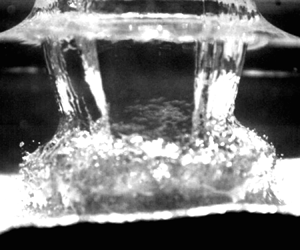No CrossRef data available.
Article contents
Cracking of submerged beds
Published online by Cambridge University Press: 14 August 2024
Abstract

We investigate the phenomena of crater formation and gas release caused by projectile impact on underwater beds, which occurs in many natural, geophysical and industrial applications. The bed in our experiment is constructed of hydrophobic particles, which trap a substantial amount of air in the pores of the bed. In contrast to dry beds, the air–water interface in a submerged bed generates a granular skin that provides rigidity to the medium by producing skin over the bulk. The projectile's energy is used to reorganize the grains, which causes the skin to crack, allowing the trapped air to escape. The morphology of the craters as a function of impact energy in submerged beds exhibits different scaling laws than what is known for dry beds. This phenomenon is attributed to the contact line motion on the hydrophobic fractal-like surface of submerged grains. The volume of the gas released is a function of multiple factors, chiefly the velocity of the projectile, depth of the bed and depth of the water column.
JFM classification
- Type
- JFM Papers
- Information
- Copyright
- © The Author(s), 2024. Published by Cambridge University Press





